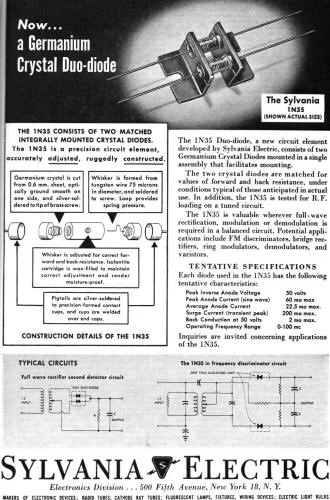|
July 1946 QST
 Table of Contents Table of Contents
Wax nostalgic about and learn from the history of early electronics. See articles
from
QST, published December 1915 - present (visit ARRL
for info). All copyrights hereby acknowledged.
|
When semiconductor devices first came onto
the electronics scene, there was a lot of resistance (no pun intended) to adopting
and designing them into circuits. Some of the reluctance (doh, another unintentional
pun) was justified in that reliability could be an issue, due primarily to the mechanical
contacts that interface wire leads to the semiconductor elements. In an effort to
mitigate some of the fear of a new type of component, often times familiar names
were given to them, such as with this duo-diode. Duo-diode vacuum tubes, the integration
of two separate diodes into a single glass enclosure, were commonly used in balanced
signal detectors because it was a way to achieve nearly exact performance in the
pair that would track equally even as the tube degraded over time. This 'duo-diode'
is a set of tested and matched germanium diodes meant for similar applications.
Calling it a 'duo-diode' helped to lower the barrier (last unintentional pun, I
promise) to adaptation by vacuum tube hardliners.
Sylvania Electric Advertisement
 Now... a Germanium Crystal Duo-diode Now... a Germanium Crystal Duo-diode
The Sylvania 1N35 (Shown Actual Size)
The 1N35 Consists of Two Matched Integrally Mounted Crystal Diodes.
The 1N35 is a precision circuit element, accurately adjusted, ruggedly constructed.
Germanium crystal is cut from 0.6 mm. sheet, optically ground smooth on one side,
and silver-soldered to tip of brass screw.
Whisker is formed from tungsten wire 75 microns in diameter, and soldered to
screw. Loop provides spring pressure.
Whisker is adjusted for correct forward and back resistance. Isotantite cartridge
is wax-filled to maintain correct adjustment and render moisture-proof.
Pigtails are silver-soldered to precision-formed contact cups, and cups are welded
over end caps.
Construction Details of the 1N35
The 1N35 Duo-diode, a new circuit element developed by Sylvania Electric, consists
of two Germanium Crystal Diodes mounted in a single assembly that facilitates mounting.
The two crystal diodes are matched for values of forward and back resistance,
under conditions typical of those anticipated in actual use. In addition, the 1N35
is tested for R.F. loading on a tuned circuit.
The 1N35 is valuable wherever full-wave rectification, modulation or demodulation
is required in a balanced circuit. Potential applications include FM discriminators,
bridge rectifiers, ring modulators, demodulators, and varistors.
Tentative Specifications
Each diode used in the 1N35 has the following tentative characteristics:
Peak Inverse Anode Voltage
50 volts
Peak Anode Current (sine wave)
60 ma max
Average Anode Current
22.5 ma max.
Surge Current (transient peak)
200 ma max.
Back Conduction at 50 volts
2 ma max.
Operating Frequency Range
0-100 mc
Inquiries are invited concerning applications of the 1N35.
Sylvania Electric
Electronics Division ... 500 Fifth Avenue, New York 18, N. Y.
Makers of Electronic Devices; Radio Tubes; Cathode Ray Tubes; Fluorescent Lamps,
Fixtures, Wiring Devices; Electric Light Bulbs
Posted September 16, 2019
(updated from original post on 6/13/2016)
|










